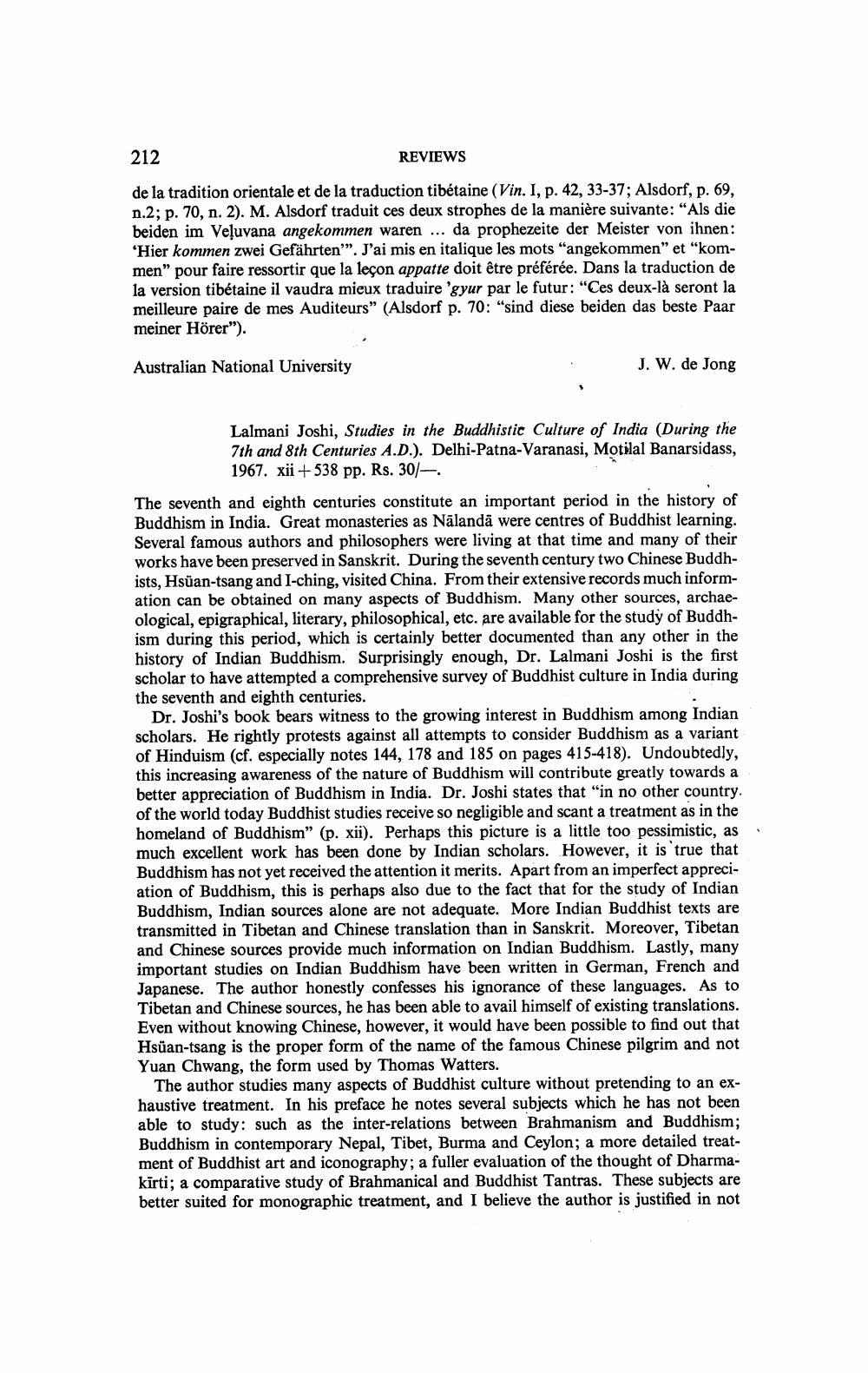Book Title: Reviews Of Different Books Author(s): Publisher: View full book textPage 6
________________ 212 REVIEWS de la tradition orientale et de la traduction tibetaine (Vin. I. p. 42. 33-37: Alsdorf. p. 69. n.2; p. 70, n. 2). M. Alsdorf traduit ces deux strophes de la maniere suivante: "Als die beiden im Veluvana angekommen waren ... da prophezeite der Meister von ihnen: 'Hier kommen zwei Gefahrten"". J'ai mis en italique les mots "angekommen" et "kommen" pour faire ressortir que la lecon appatte doit etre preferee. Dans la traduction de la version tibetaine il vaudra mieux traduire 'gyur par le futur: "Ces deux-la seront la meilleure paire de mes Auditeurs" (Alsdorf p. 70: "sind diese beiden das beste Paar meiner Horer"). Australian National University J. W. de Jong Lalmani Joshi, Studies in the Buddhistic Culture of India (During the 7th and 8th Centuries A.D.). Delhi-Patna-Varanasi, Motilal Banarsidass, 1967. xii + 538 pp. Rs. 30/ The seventh and eighth centuries constitute an important period in the history of Buddhism in India. Great monasteries as Nalanda were centres of Buddhist learning. Several famous authors and philosophers were living at that time and many of their works have been preserved in Sanskrit. During the seventh century two Chinese Buddhists, Hsuan-tsang and I-ching, visited China. From their extensive records much information can be obtained on many aspects of Buddhism. Many other sources, archaeological, epigraphical, literary, philosophical, etc. are available for the study of Buddhism during this period, which is certainly better documented than any other in the history of Indian Buddhism. Surprisingly enough, Dr. Lalmani Joshi is the first scholar to have attempted a comprehensive survey of Buddhist culture in India during the seventh and eighth centuries. Dr. Joshi's book bears witness to the growing interest in Buddhism among Indian scholars. He rightly protests against all attempts to consider Buddhism as a variant of Hinduism (cf. especially notes 144, 178 and 185 on pages 415-418). Undoubtedly, this increasing awareness of the nature of Buddhism will contribute greatly towards a better appreciation of Buddhism in India. Dr. Joshi states that "in no other country. of the world today Buddhist studies receive so negligible and scant a treatment as in the homeland of Buddhism" (p. xii). Perhaps this picture is a little too pessimistic, as. much excellent work has been done by Indian scholars. However, it is true that Buddhism has not yet received the attention it merits. Apart from an imperfect appreciation of Buddhism, this is perhaps also due to the fact that for the study of Indian Buddhism, Indian sources alone are not adequate. More Indian Buddhist texts are transmitted in Tibetan and Chinese translation than in Sanskrit. Moreover, Tibetan and Chinese sources provide much information on Indian Buddhism. Lastly, many important studies on Indian Buddhism have been written in German, French and Japanese. The author honestly confesses his ignorance of these languages. As to Tibetan and Chinese sources, he has been able to avail himself of existing translations. Even without knowing Chinese, however, it would have been possible to find out that Hsuan-tsang is the proper form of the name of the famous Chinese pilgrim and not Yuan Chwang, the form used by Thomas Watters. The author studies many aspects of Buddhist culture without pretending to an exhaustive treatment. In his preface he notes several subjects which he has not been able to study: such as the inter-relations between Brahmanism and Buddhism; Buddhism in contemporary Nepal, Tibet, Burma and Ceylon; a more detailed treatment of Buddhist art and iconography; a fuller evaluation of the thought of Dharmakirti; a comparative study of Brahmanical and Buddhist Tantras. These subjects are better suited for monographic treatment, and I believe the author is justified in notPage Navigation
1 ... 4 5 6 7 8 9 10 11 12 13 14 15 16 17 18 19 20 21
